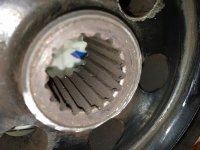pontow
New member
The bike is a 2015 RT-S SE6. Mileage is a bit over 15,000. Front Pulley had to be replaced. Three months out of stock warranty. BEST warranty says it's a "wear item" so it won't cover it. BRP did step up with a "Good Will" coverage so Thank You, BRP. A shout out to Escondido Cycle Center for their excellent service since they are behind during jet ski season here in the San Diego area and we are leaving for a 2500+ mile trip to Bend, OR and back on September 5th. The shop properly diagnosed, negotiated the warranty coverage, ordered the part and performed the repair all in a 9 day time frame. Thanks Guys!! You saved our vacation!
So, I had been off of the bike for about 2 months due to a surgery. First time back on, did about 110 miles with some friends and noticed a distinct gravelly, grinding, not pleasant sound coming from the left front side of the bike but only during deceleration. When I was accelerating, it was fine. When I was pretty "neutral" in my speed, it was fine. Only could hear it when there was engine back pressure while slowing down. I'm thinking that the condition came on slowly and therefore my ears got more and more used to it. The absence off of the bike allowed me to get back on fresh and say "hey, that ain't right".
The mechanic at the shop could easily hear the noise. He pulled some tupperware and his first telltale sign was some reddish, powdery deposits on the inside of the cover that goes over the pulley. He had seen this previously on a couple of RS's he said but never on an RT. Once he removed the bolt from the pulley the one sided wear on the pulley teeth were very obvious. He said that the splines on the shaft coming out of the transmission are cut in such a way that they don't go across the entire width of the pulley so this made it pretty difficult to get the pulley off. The wear had left a small full portion area of the spline tooth at both the front and back face of the pulley, probably with a substantial burr in those areas as well. It took some work to get the pulley off.
Hope this information might help somebody else with a proper diagnosis. The talent of Herme the mechanic saved us from possibly tearing into the transmission for no good reason, being without the bike for an extended period and missing the vacation we had planned for a year.
So, I had been off of the bike for about 2 months due to a surgery. First time back on, did about 110 miles with some friends and noticed a distinct gravelly, grinding, not pleasant sound coming from the left front side of the bike but only during deceleration. When I was accelerating, it was fine. When I was pretty "neutral" in my speed, it was fine. Only could hear it when there was engine back pressure while slowing down. I'm thinking that the condition came on slowly and therefore my ears got more and more used to it. The absence off of the bike allowed me to get back on fresh and say "hey, that ain't right".
The mechanic at the shop could easily hear the noise. He pulled some tupperware and his first telltale sign was some reddish, powdery deposits on the inside of the cover that goes over the pulley. He had seen this previously on a couple of RS's he said but never on an RT. Once he removed the bolt from the pulley the one sided wear on the pulley teeth were very obvious. He said that the splines on the shaft coming out of the transmission are cut in such a way that they don't go across the entire width of the pulley so this made it pretty difficult to get the pulley off. The wear had left a small full portion area of the spline tooth at both the front and back face of the pulley, probably with a substantial burr in those areas as well. It took some work to get the pulley off.
Hope this information might help somebody else with a proper diagnosis. The talent of Herme the mechanic saved us from possibly tearing into the transmission for no good reason, being without the bike for an extended period and missing the vacation we had planned for a year.

